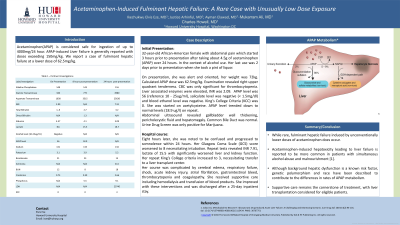Monday Poster Session
Category: Liver
P2575 - Acetaminophen-Induced Fulminant Hepatic Failure: A Rare Case With Unusually Low Dose Exposure
Monday, October 23, 2023
10:30 AM - 4:15 PM PT
Location: Exhibit Hall

Has Audio

Ikechukwu Eze, MD
Howard University Hospital
Washington, DC
Presenting Author(s)
Ikechukwu Eze, MD1, Justice Arhinful, MD2, Ayman Elawad, MD1, Mukarram Jamat Ali, MD1, Charles Howell, MD2
1Howard University Hospital, Washington, DC; 2Howard University, Washington, DC
Introduction: Acetaminophen(APAP) is considered safe for ingestion of up to 4000mg every 24 hour. APAP-induced Liver Failure is generally reported with doses exceeding 150mg/kg. We report a case of fulminant hepatic failure at a lower dose of 62.5mg/kg.
Case Description/Methods: We present a 32-year-old African-American female with abdominal pain which started 3 hours prior to presentation after taking about 4.5g of acetaminophen (APAP) over 24 hours. She endorsed daily alcohol use with last use 2 days prior to presentation when she took a pint of liquor.
She was alert and oriented, her weight was 72kg. APAP dose was 62mg/kg. She had right upper quadrant tenderness. Alkaline Phosphatase (ALP) was 148, Alanine Transaminase (ALT) 346, Aspartate transaminase (AST) 1638 and her International Normalized ratio (INR) was 2.09. APAP level was 56 (reference 10 - 25 ug/ml), salicylate level was negative (< 1.5mg/dl) and blood ethanol level was negative. Urine drug screen was only positive for marijuana. King’s College Criteria (KCC) was 1. She was started on acetylcysteine. APAP level trended down to normal levels (18.9 ug/l) on repeat. Abdominal ultrasound revealed gallbladder wall thickening, pericholecystic fluid and hepatomegaly. Acalculous cholecystitis was suspected.
Eight hours later, she was noted to be confused and then somnolent. Her Glasgow Coma Scale (GCS) score was 8 necessitating endotracheal intubation. Repeat tests revealed INR 7.91, lactate 15.5, AST 25620, ALT 4980, Total Bilirubin 3.2, LDH 23740, Cr 2.66, NH3 414. Her repeat KCC increased to 3, necessitating transfer to a liver transplant center. Extensive testing for viral, immunologic and other toxic causes were all negative. Her course was complicated by cerebral edema, respiratory failure, shock, acute kidney injury, atrial fibrillation, gastrointestinal bleed, thrombocytopenia and coagulopathy. She received supportive care including hemodialysis and transfusion of blood products. She did not meet criteria for liver transplantation but made a good recovery with supportive care. She was discharged after a 25-day inpatient stay with follow up.
Discussion: While rare, fulminant hepatic failure induced by unconventionally lower doses of acetaminophen does occur. Although background hepatic dysfunction is a known risk factor, genetic polymorphism and race have been described to contribute to the differences in rates of APAP metabolism. Supportive care remains the cornerstone of treatment, with liver transplantation considered for eligible patients.
Disclosures:
Ikechukwu Eze, MD1, Justice Arhinful, MD2, Ayman Elawad, MD1, Mukarram Jamat Ali, MD1, Charles Howell, MD2. P2575 - Acetaminophen-Induced Fulminant Hepatic Failure: A Rare Case With Unusually Low Dose Exposure, ACG 2023 Annual Scientific Meeting Abstracts. Vancouver, BC, Canada: American College of Gastroenterology.
1Howard University Hospital, Washington, DC; 2Howard University, Washington, DC
Introduction: Acetaminophen(APAP) is considered safe for ingestion of up to 4000mg every 24 hour. APAP-induced Liver Failure is generally reported with doses exceeding 150mg/kg. We report a case of fulminant hepatic failure at a lower dose of 62.5mg/kg.
Case Description/Methods: We present a 32-year-old African-American female with abdominal pain which started 3 hours prior to presentation after taking about 4.5g of acetaminophen (APAP) over 24 hours. She endorsed daily alcohol use with last use 2 days prior to presentation when she took a pint of liquor.
She was alert and oriented, her weight was 72kg. APAP dose was 62mg/kg. She had right upper quadrant tenderness. Alkaline Phosphatase (ALP) was 148, Alanine Transaminase (ALT) 346, Aspartate transaminase (AST) 1638 and her International Normalized ratio (INR) was 2.09. APAP level was 56 (reference 10 - 25 ug/ml), salicylate level was negative (< 1.5mg/dl) and blood ethanol level was negative. Urine drug screen was only positive for marijuana. King’s College Criteria (KCC) was 1. She was started on acetylcysteine. APAP level trended down to normal levels (18.9 ug/l) on repeat. Abdominal ultrasound revealed gallbladder wall thickening, pericholecystic fluid and hepatomegaly. Acalculous cholecystitis was suspected.
Eight hours later, she was noted to be confused and then somnolent. Her Glasgow Coma Scale (GCS) score was 8 necessitating endotracheal intubation. Repeat tests revealed INR 7.91, lactate 15.5, AST 25620, ALT 4980, Total Bilirubin 3.2, LDH 23740, Cr 2.66, NH3 414. Her repeat KCC increased to 3, necessitating transfer to a liver transplant center. Extensive testing for viral, immunologic and other toxic causes were all negative. Her course was complicated by cerebral edema, respiratory failure, shock, acute kidney injury, atrial fibrillation, gastrointestinal bleed, thrombocytopenia and coagulopathy. She received supportive care including hemodialysis and transfusion of blood products. She did not meet criteria for liver transplantation but made a good recovery with supportive care. She was discharged after a 25-day inpatient stay with follow up.
Discussion: While rare, fulminant hepatic failure induced by unconventionally lower doses of acetaminophen does occur. Although background hepatic dysfunction is a known risk factor, genetic polymorphism and race have been described to contribute to the differences in rates of APAP metabolism. Supportive care remains the cornerstone of treatment, with liver transplantation considered for eligible patients.
Disclosures:
Ikechukwu Eze indicated no relevant financial relationships.
Justice Arhinful indicated no relevant financial relationships.
Ayman Elawad indicated no relevant financial relationships.
Mukarram Jamat Ali indicated no relevant financial relationships.
Charles Howell indicated no relevant financial relationships.
Ikechukwu Eze, MD1, Justice Arhinful, MD2, Ayman Elawad, MD1, Mukarram Jamat Ali, MD1, Charles Howell, MD2. P2575 - Acetaminophen-Induced Fulminant Hepatic Failure: A Rare Case With Unusually Low Dose Exposure, ACG 2023 Annual Scientific Meeting Abstracts. Vancouver, BC, Canada: American College of Gastroenterology.
